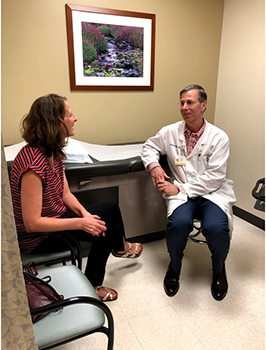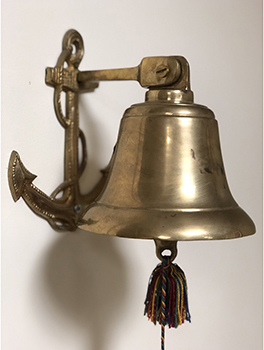C-RAD targets cells, protects heart
August 10, 2018

Tricia Hasan uses humor to get through tough times. After being diagnosed with Stage 0, Ductal Carcinoma in Situ (DCIS) in December of 2017, she joked, “I got breast cancer for Christmas.”
Tricia, a 46-year-old Arlington Heights resident and mother of three had been to the NCH Breast Center many times for annual mammograms. In 2017, she opted for the 3D mammogram technology instead of her usual standard mammogram. The result came back looking suspicious, which prompted her to return for an ultrasound.
Tricia underwent two lumpectomies. One was performed in January and another in February when it was discovered that tiny cells traveling down the ducts were still present at the resection margin.
Thanks to better imaging and a dedicated team of medical professionals at NCH, says Stephen Nigh, M.D., Radiation Oncologist and Medical Director of Cancer Services at NCH, “The cure rate for this type of cancer is 98 to 100 percent.” Tricia’s type of cancer represents 20 percent of breast cancer cases, and even though it is considered precancerous, it can return, which is why it’s imperative to prevent it from recurring.
“Half of the time, it comes back as an invasive cancer,” Dr. Nigh says. “Our whole goal of treatment is to prevent a recurrence.”
Tricia started radiation in April of 2018, at which time she learned she was eligible for the new radiation technology called C-RAD Optical Surface Monitoring System (OSMS). She was the first patient to use it at NCH. C-RAD protects the heart and other healthy tissues for left-sided breast cancer patients like Tricia.
“We are doing everything we can to make sure there’s no exposure to the heart with radiation,” Dr. Nigh explains. “We really think this technology gives us and our patients a lot of confidence.”
How it works
Tricia jokingly named the treatment “Atari Yoga” referring to the classic video tennis game coupled with deep breathing. She explained that she was watching an orange ball rise and fall on a monitor and it helped her control her breathing during radiation so that the laser beam could precisely target the cancer cells and not her heart or lungs.
“By holding your breath, they’re making sure that the laser is more focused,” Tricia says. “Everyone was very intrigued with how it was working.”
“This is maximally reducing the radiation dose to the heart,” Dr. Nigh explains.
When Tricia finished all 21 days of her treatment, she celebrated with a long-held tradition at NCH Cancer Services. “You get to ring a bell and they give you a certificate,” Tricia says. She adds that she feels fortunate that the 3D mammogram and C-RAD were available to her.
“This is the first time I did the 3D mammogram,” she says. “It’s important to get your mammograms.”
Standard of care

In the first quarter of 2018, 3D mammography became the standard of care for patients at all of the NCH Breast Imaging Centers.
Patients who have dense breast tissue also may need automated breast ultrasound (ABUS) for greater detection.
“3D mammography is better at picking up lesions in patients that have dense breasts,” Dr. Nigh says. “It’s just a clearer picture than the older mammograms and it certainly picks it up at an earlier stage.”
Working full-time and juggling her family’s needs with radiation treatments might have been more difficult if it hadn’t been for the organized staff in Cancer Services, Tricia maintains. “I never felt like I was waiting. They even give you a parking pass for oncology parking so you don’t have to worry about parking.”
NCH offers same-day results for low-dose 3D mammography and automated breast ultrasounds (ABUS) at four imaging locations.
Call 847-618-3700 to schedule an appointment.